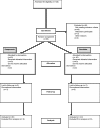A comparison of oral omeprazole and intravenous cimetidine in reducing complications of duodenal peptic ulcer
- PMID: 16403233
- PMCID: PMC1360671
- DOI: 10.1186/1471-230X-6-2
A comparison of oral omeprazole and intravenous cimetidine in reducing complications of duodenal peptic ulcer
Abstract
Background: Gastrointestinal bleeding is a common problem and its most common etiology is peptic ulcer disease. Ulcer rebleeding is considered a perilous complication for patients. To reduce the rate of rebleeding and to fasten the improvement of patients' general conditions, most emergency departments in Iran use H2-blockers before endoscopic procedures (i.e. intravenous omeprazole is not available in Iran). The aim of this study was to compare therapeutic effects of oral omeprazole and intravenous cimetidine on reducing rebleeding rates, duration of hospitalization, and the need for blood transfusion in duodenal ulcer patients.
Methods: In this clinical trial, 80 patients with upper gastrointestinal bleeding due to duodenal peptic ulcer and endoscopic evidence of rebleeding referring to emergency departments of Imam and Sina hospitals in Tabriz, Iran were randomly assigned to two equal groups; one was treated with intravenous cimetidine 800 mg per day and the other, with 40 mg oral omeprazole per day.
Results: No statistically significant difference was found between cimetidine and omeprazole groups in regards to sex, age, alcohol consumption, cigarette smoking, NSAID consumption, endoscopic evidence of rebleeding, mean hemoglobin and mean BUN levels on admission, duration of hospitalization and the mean time of rebleeding. However, the need for blood transfusion was much lower in omeprazole than in cimetidine group (mean: 1.68 versus 3.58 units, respectively; p < 0.003). Moreover, rebleeding rate was significantly lower in omeprazole group (15%) than in cimetidine group (50%) (p < 0.001).
Conclusion: This study demonstrated that oral omeprazole significantly excels intravenous cimetidine in reducing the need for blood transfusion and lowering rebleeding rates in patients with upper gastrointestinal bleeding. Though not statistically significant (p = 0.074), shorter periods of hospitalization were found for omeprazole group which merits consideration for cost minimization.
Figures
Similar articles
-
A prospective randomized comparative trial showing that omeprazole prevents rebleeding in patients with bleeding peptic ulcer after successful endoscopic therapy.Arch Intern Med. 1998 Jan 12;158(1):54-8. doi: 10.1001/archinte.158.1.54. Arch Intern Med. 1998. PMID: 9437379 Clinical Trial.
-
Can optimal acid suppression prevent rebleeding in peptic ulcer patients with a non-bleeding visible vessel: a preliminary report of a randomized comparative study.Hepatogastroenterology. 1997 Sep-Oct;44(17):1495-9. Hepatogastroenterology. 1997. PMID: 9356879 Clinical Trial.
-
Will Helicobacter pylori affect short-term rebleeding rate in peptic ulcer bleeding patients after successful endoscopic therapy?Am J Gastroenterol. 1999 Nov;94(11):3184-8. doi: 10.1111/j.1572-0241.1999.01516.x. Am J Gastroenterol. 1999. PMID: 10566712
-
[Intravenous omeprazole versus ranitidine in the treatment of hemorrhagic duodenal ulcer: a prospective randomized study].Ann Chir. 1997;51(2):136-9. Ann Chir. 1997. PMID: 9297869 Review. French.
-
Ulcers and nonvariceal bleeding.Endoscopy. 2003 Jan;35(1):22-6. doi: 10.1055/s-2003-36411. Endoscopy. 2003. PMID: 12510222 Review.
Cited by
-
Trends and predictors for vagotomy when performing oversew of acute bleeding duodenal ulcer in the United States.J Gastrointest Surg. 2007 Jan;11(1):22-8. doi: 10.1007/s11605-006-0020-z. J Gastrointest Surg. 2007. PMID: 17390182
-
Evidence-based clinical practice guidelines for peptic ulcer disease 2015.J Gastroenterol. 2016 Mar;51(3):177-94. doi: 10.1007/s00535-016-1166-4. Epub 2016 Feb 15. J Gastroenterol. 2016. PMID: 26879862
-
Proton pump inhibitors: use, misuse and concerns about long-term therapy.Clin J Gastroenterol. 2011 Apr;4(2):53-9. doi: 10.1007/s12328-011-0208-y. Epub 2011 Feb 18. Clin J Gastroenterol. 2011. PMID: 26190705
-
Etiology and outcome of acute gastrointestinal bleeding in iran:a review article.Middle East J Dig Dis. 2012 Oct;4(4):193-8. Middle East J Dig Dis. 2012. PMID: 24829656 Free PMC article. Review.
References
-
- Loren L. Gastrointestinal bleeding. Textbook of Harrison's principles of Internal Medicine. 15. Vol. 1. McGraw hill, USA; 2001. p. 252.
-
- Shafi MA, Fleischer DE. Risk factors of acute ulcer bleeding. Hepatogastroenterology. 1999:727–31. - PubMed
-
- Lin HJ, Lo WC, Lee FY, Perng CL, Tsenng GY. A prospective randomized comparative trial showing that Omeprazole prevents rebleeding in patients with bleeding peptic ulcer after successful endoscopic therapy. Arch Intern Med. 158:54–58. 1998 Jan; 12. - PubMed
Publication types
MeSH terms
Substances
LinkOut - more resources
Full Text Sources
Medical


